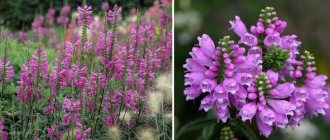- September 14, 2018
- Flowers
- Natalia Miroshnikova
Flowering vines look very impressive, and such plants are popular with gardeners. But not all such cultures are endowed with an unpretentious character. A pleasant exception to the rule is calystegia terry, which is also called the Siberian rose. With minimal care, this climbing plant grows quickly and delights with numerous and large buds.
Description
Calistegia terry is a climbing vine belonging to the Convolvulaceae family. This herbaceous perennial, which came to us from East Asia, is distinguished by a highly developed root system. The whitish dense shoots are capable of occupying a large area and displacing other crops from it. Therefore, the growth of the vine must be limited.
The plant's smooth and flexible vines, covered with brownish skin, reach 4 meters in length. They bear heart-shaped or triangular leaves, painted in light or dark green tones. The plates with a relief pattern on the surface have pointed tips and wavy sides.
But the main value of the vine lies in its large double buds. They densely cover the plant's vines from the beginning of summer until frost. The diameter of the peduncles reaches up to 10–12 cm. The thin delicate petals of the crop are colored pink or white. After the buds, seed boxes are formed. With the arrival of cold weather, all above-ground parts of the crop die off, only the strong rhizome remains alive, which will produce new shoots next spring.
Popular types
There are 25 varieties of vines, but only three are grown as ornamental crops. The rest grow like weeds. So, for the garden, choose the following types of plants:
- Calistegia fluffy. The plant is characterized by rapid growth and shoots reaching up to 4 meters in length. The strong branches of the vine are densely covered with leathery, oblong, emerald leaves. The buds are usually double. But there are varieties with simple bell-shaped peduncles. The diameter of the buds reaches 3–9 cm. The petals are painted in soft pink tones with a dark base.
- Calistegia multiplex. The shoots of the vine reach 3–4 meters in length. They are covered with dark green triangular shaped leaves. The plates are located close to each other, which gives special splendor to the branches. But the main value of the variety is its large double buds, reaching 10 cm in diameter. The petals are painted in bright pink tones. Calistegia multiplex is the most demanding of regular feeding.
- Calistegia ivy leaf. This variety is also called Japanese. The plant is characterized by rapid growth. Its shoots reach 1.5–2 meters in length. On the elastic branches there are small alternate leaves and large double buds with a diameter of up to 9 cm. The vine begins to flower in July and ends by the end of September.
Each of these varieties will decorate the site. But for this you will need to create comfortable conditions for the plants and provide the vines with minimal care.
Plant conditions
Calistegia, planting and caring for which is not particularly difficult, is unpretentious, frost- and drought-resistant. However, a gardener who wants to turn it into the “highlight” of his garden plot will have to provide the plant with comfortable living conditions.
Lighting
Calistegia will actively grow in partial shade and dense shade, but in this case you should not expect abundant flowering from it. The first buds will appear 3 weeks late. For this reason, it is advisable to find a well-lit area for the plant.
The best option for planting would be a place where intense sunlight is present in the morning, and openwork partial shade reigns in the 2nd half of the day.
Temperature
Calistegia feels great at temperatures of 22-25o C ; at temperatures approaching 300 C, the leaves begin to wither. This fact is associated with the requirement for partial shade in the area in the afternoon, when solar activity is maximum.
Humidity
Calistegia is a drought-resistant plant; it does not like dampness; if the humidity is too high, it can develop powdery mildew or root rot.
Damp areas located in lowlands and wetlands are not suitable for it.
Soil and drainage
The plant readily grows in fertile, loose, oxygenated soils of moderate humidity.
What he likes most:
- peat bogs;
- loam;
- deciduous soil.
Due to the active growth of Calistegia, a large amount of nutrients is required, so even with the most fertile soil it is impossible to do without fertilizing.
If the soil is excessively wet, the area will need to be drained, for which it is recommended to equip it with a drainage system:
- Remove the fertile layer.
- Dig a trench 80 cm deep and lay a layer of crushed stone on its bottom with a slight slope.
- Place a perforated drainage pipe on the crushed stone.
- Place a second layer of crushed stone on top of the pipe.
- Return the fertile layer.
Watering
Calistegia is not afraid of a short-term lack of moisture, since its developed root system is capable of reserving water “in reserve.” For this reason, watering is only necessary during a long absence of rain. A signal that a plant is experiencing a moisture deficiency is its drooping leaves.
Selecting a location
The plant does not tolerate transplantation well and grows in one place for up to 20 years. Select a site taking into account this feature of the vine. Calistegia is a light-loving flower. Therefore, the curly beauty requires the most illuminated open spaces. The southern or eastern side of the site is suitable, preferably on a small hill. Since in lowlands and places with close soil, the roots of the plant rot.
Do not grow the crop near buildings, high fences or in the shade of large trees. This will cause the color of the petals to fade significantly, and the flowering itself will occur two weeks later and will last less.
The vine does not have any special requirements for soil. But it develops better in areas with nutritious and loose soil. In such conditions, the plant lives up to 10 years and annually pleases with long and multi-membered flowering.
Landing
Start the event in early spring. Before planting, be sure to harden off the seedlings. Take them out into the fresh air for two weeks and leave them for an hour. Plant the plants in a trench 25–30 cm deep. If the groundwater in the area lies close to the soil surface, be sure to provide drainage. To do this, pour a 5-centimeter layer of broken brick or coarse sand onto the bottom of the trench.
Plant seedlings at a distance of 20 cm from each other. Make sure that the root collar is level with the ground. After planting terry calistegia, moisten the soil well and mulch the surface with peat or humus. This layer will feed the plants, also retain moisture in the soil and prevent weeds from appearing.
Please note that calistegia terry is a vine that grows strongly. And if its development is not controlled, it will quickly take over free space and displace other cultures from there. Therefore, limit its growth with pieces of slate, plastic or mesh tape 50 cm wide. Dig these materials around the crop to a depth of 40 cm.
How to care
Watering
No special care is required for calistegia. This plant is distinguished by its unpretentiousness: it can tolerate both cold and drought. During the rainy season, there is no need to water the plant, but on hot, dry days, try to keep the soil moist.
The soil
Don't forget to loosen the soil with a pitchfork. Do this not too deep - 2-3 centimeters is enough.
Top dressing
Due to the rapidity of its growth, calistegia requires feeding. Do this systematically and with specialized mineral fertilizers. The plant should also be fed before the start of the growing season. This is done in early spring with the help of organic fertilizers and humus.
Trimming
It is also important to pick off drying flowers so that new ones can grow in their place. This must be done throughout the flowering period. After the growing season, be sure to prune old shoots. Thanks to this, the plant will endure the winter easier and produce more flowers in the spring.
Wintering
As mentioned earlier, calistegia is a fairly frost-resistant plant. However, if the winter promises to be little snow and harsh, take care of shelter for the rootstock in advance. Cover the plant with peat or dry fallen leaves.
Transfer
You can replant Calistegia pova, but not in the summer. During this period, the plant’s roots are too active and replanting can destroy them. But in the fall the transplant will be safe. Try not to plant the rootstock next to flower beds, otherwise the calystegia will take over the entire surrounding area.
Reproduction
Calistegia can only be propagated at home using the vegetative method. To do this, take the root cuttings and replant them in previously prepared soil.
Care
Growing terry calistegia in the garden will not cause much trouble, because the vine is unpretentious and does not require special attention. However, in order to achieve lush and numerous buds from it, you will need to carry out such agrotechnical measures as:
- periodic watering;
- regular feeding;
- pruning and crown formation;
- preparation for winter;
- prevention of diseases and pests.
In addition, in order for the plant to develop well, it is important to provide it with support. For this purpose, use tripods, inclined rods, and gratings. If you wish, you can even build an arch, and terry calistegia will easily wrap around it. But keep in mind that the diameter of the support should not exceed 10 cm. Otherwise, the vine will have difficulty climbing it.
Using calistegia in the landscape
The plant is used in garden plots as a green vertical decoration. After all, a gazebo entwined with multi-colored double flowers looks amazing. Along the chain-link mesh, the calistegia will form a living carpet. Gardeners plant different species in the same area, and it turns out very beautiful when they intertwine.
No need to use on flower beds and flower beds. There is no way to install a barrier for the roots, and the calistegia will spread throughout the area. Give the plant a separate area.
Alternatively, they are planted in boxes and installed on the balcony.
Watering
Calistegia terry, photos of which are given in the material, is a drought-resistant plant. And it has enough groundwater and rainfall. But if the summer turns out to be hot and dry, then water the flower occasionally.
Young seedlings in the first year after planting need more frequent irrigation, because their roots are not yet strong enough and do not draw moisture from the soil. Therefore, moisten the soil as it dries. But don’t get carried away with watering, because young plants will die from stagnation of moisture.
Preparing for winter
Calistegia terry is a frost-resistant plant. And in the middle zone, it calmly endures the cold season even without shelter. But if a frosty and snowless winter is expected, then it is better to prepare the crop for it. To do this, cut off all above-ground parts of the plant, because they will die from frost anyway. After this, sprinkle the vine's trunk circle with fallen leaves, peat or sawdust.
Reproduction by root shoots
Calistegia terry is a very life-loving crop. And during growth it produces a mass of root shoots. They can be used to propagate the flower. To do this, dig up the shoot and transplant it to a suitable place. During the event, do not forget to water the seedling.
The vine can be propagated from spring to late autumn. But when planting before winter, do not forget to insulate the seedlings. Otherwise they will not survive until spring. To do this, cover the tree trunk circle with a 5-centimeter layer of peat or sawdust. And cover the planting with non-woven material, for example, lutrasil.
Growing bindweed
Plant propagation
Calistegia has no problems with reproduction. Even a small piece of root will grow into a vine. Therefore, ornamental plant varieties are propagated by root division. If the plant does not tolerate winter cold, the root is dug up, placed in a box, covered with soil and stored until spring planting. In winter, the soil is moistened.
Planting a vine
When planting, the root is divided into pieces. In the place where the cuts are, they are treated with crushed tablets of activated carbon or crushed charcoal. Planting depth is 3 cm. These root pieces are planted in peat cups and watered abundantly. When the development of the rootstocks begins, the tops are pinched off. This will make the bush thicker.
In the second half of May, these bushes are planted in the place where you want to see the beautiful liana. Don't forget to protect the roots from spreading.
Diseases and pests
Calistegia terry belongs to plants with strong immunity. But if the summer turns out to be rainy and cold, then the crop may suffer from fungal diseases, for example, root rot or powdery mildew. For treatment, treat the vine with the fungicide “Fitosporin” or “Topaz”. But in order to prevent the development of the disease, it is better to spray the plant in the spring for preventative purposes.
Calistegia is quite poisonous, and most pests avoid it. But the vine is loved by snails and slugs, and these insects are capable of destroying the foliage and buds of the plant in a short time. To get rid of parasites, treat the crop with Karbofos or Thunderstorm. Egg shells also help repel pests. It should be crushed and scattered near the tree trunk.
Why does the plant dry out and turn yellow?
Unless this is seasonal, completely natural wilting, then yellowing of the leaves is an alarming sign that may indicate:
- deficiency or excess of moisture;
- diseases of the root system (root rot);
- damage by powdery mildew or pests;
- lack of nutrients in the soil.
If in the first case it is only necessary to change the watering regime, then for all other reasons for early wilting, more complex actions will be required.
Reviews
Calistegia terry is popular among gardeners. According to reviews, this vine is the best plant for decorating nondescript buildings, fences and any supports. After all, the plant grows quickly and reaches enormous sizes in a short time. In addition, for 3-4 months a year it is covered with attractive buds that exude a pleasant aroma.
In addition, the advantages of the crop include frost resistance, resistance to diseases and pests, as well as its unpretentious nature and minimal care requirements. Therefore, if you want to easily grow a beautiful climbing plant, hide a landscape imperfection, or decorate the wall of a building, then pay attention to terry calistegia. This vine will not disappoint you.











